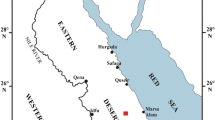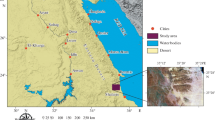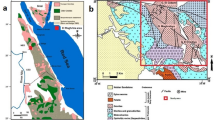Abstract
The recorded uranium mineralization is genetically related to the U content and structural setting of syenogranitic dyke that occurs near alkaline granites, Abu Hamr area, north Eastern Desert of Egypt. The associated abnormal level of radioactivity exhibits maximum equivalent uranium (eU) of 155.6 parts per million (ppm) with an average of 54 ppm while the maximum of eTh reaches up to 235 ppm with average content of 120 ppm. The nearby alkaline granites of Gabal Abu Hamr show a normal distribution of eU and eTh resembling that of normal granites (4 ppm eU and 8 ppm eTh). Radioactive anomalies can be interpreted as successive concentrations of U-Th, which are related to magmatic processes of syn-shearing syenogranite dyke formation followed by hydrothermal redistribution during the emplacement, and then supergene enrichment. Testing of uranium equilibrium has revealed major chemical U addition to both the syenogranitic dyke and, to less extent, the alkaline granites. The rare-earth element (REE) patterns display pronounced enrichment of light REEs and heavy REEs of the syenogranitic dyke in contrast to the alkaline granites, which might have attributed to the subsequent hydrothermal circulation. The studied dyke is also characterized by well-developed U, Th, and Pb enrichments. Post-magmatic hydrothermal activity is evident from the presence of dark violet fluorite with inclusion of U and Th minerals, in addition to the presence of zircon crystals with overgrowth, xenocrystic cores, REE replacements, and spatially inclusions of allanite-(Ce) with irregularly distributed patchy overgrowths of U and Th.













Similar content being viewed by others
References
Abdel Ghani IM (2000) Geology, petrology and radioactivity of Gabal EL–Urf area, Central Eastern Desert, Egypt. Unpublished Ph.D. thesis, Facualty of Science, Sohag, South Valley Univ., Egypt, pp 273
Ali KA, Moghazi AM, Maurice AE, Omar SA, Wang Q, Wilde SA, Moussa EM, Manton WI, Stern RJ (2012) Composition, age, and origin of the ≈620 Ma Humr Akarim and Humrat Mukbid A-type granites: no evidence for pre-Neoproterozoic basement in the Eastern Desert, Egypt. Int J Earth Sci 101:1705–1722
Ali KA, Wilde SA, Stern RJ, Moghazi AM, Ameen SM (2013) Hf isotopic composition of single zircons from Neoproterozoic arc volcanics and post-collision granites, Eastern Desert of Egypt: implications for crustal growth and recycling in the Arabian-Nubian Shield. Precambrian Res 239:42–55
Assran AM, Ibrahim ME, El-Mansi MM, Abdel Ghani IM (2001) Geochemistry, petrogenesis and radioactivity of Pan-African granitoid, Fatirah area, Eastern Desert, Egypt. 5th international conference on geochemistry, Alexandria Univ, 12–13 Sept, 2001, pp 599–626
Bentor YK (1985) The crustal evolution of the Arabo–Nubian Massif with special reference to the Sinai Peninsula. Precambrian Res 28:1–74
Beyth M, Stern RJ, Altherr R, Kröner A (1994) The Late Precambrian Timna igneous complex, Southern Israel: evidence for comagmatic-type sanukitoid monzodiorite and alkali granite magma. Lithos 31:103–124
Brocker M, Franz L (2000) The contact aureole on Tinos (Cyclades, Greece): tourmaline-biotite geothermometry and Rb–Sr geochronology. J Mineral Petrol 70:257–283
Cartwright I, Buick IS (1996) Determining the direction of contact metamorphic fluid flow: an assessment of mineralogical and stable isotope criteria. J Metamorph Geol 14:289–305
Dardier AM (1999) Morphology and geochemistry of zircon associated with uranium mineralization in Gattar granitic pluton, north Eastern Desert, Egypt. J Mineralogical Soc Egypt 11:91–104
De la Roche H, Leterrier J, Grandclaude P, Marchal M (1980) A classification of volcanic and plutonic rocks using R1R2 diagram and major element analyses its relationships with current nomenclature. Chem Geol 29:183–210
El Gaby S (1975) Petrochemistry and geochemistry of some granites from Egypt. Neues Jb Mineral Abh 124:147–189
El Mahallawi MM, Ahmed AF (2012) Late Proterozoic older granitoids from the north Eastern Desert of Egypt: petrogenesis and geodynamic implications. Arab J Geosci 5:15–27
El Shazly EM (1964) On the classification of the Precambrian and other rocks of magmatic affiliation in Egypt. In: Proceedings of the 22nd international geological congress, New Delhi, 10, pp 88–101
El-Mansi MM, Dardier AM, Abdel Ghani IM (2004) Crystal habit and chemistry of zircon as a guide for uranium redistribution in Gabal Ria El-Garrah area, Eastern Desert, Egypt. Delta J Sci 28:19–30
El-Sayed MM, El-Nisr SA (1999) Petrogenesis and evolution of the Dineibit El-Qulieb hyperaluminous leucogranite, south Eastern Desert, Egypt: petrological and geochemical constraints. J Afr Earth Sci 28(3):703–720
El-Sayed MM, Mohamed FH, Furnes H, Kanisawa S (2002) Geochemistry and petrogenesis of the Neoproterozoic granitoids in the central Eastern Desert, Egypt. Chemie der Erde/Geochemistry 62(4):317–346
El-Tahir M (1996) Distribution of radioactive elements in Gabal Abu Hamr riebeckite granite, Eastern Desert of Egypt, as a guide to uranium exploration. Bull Fac Sci Assiut Univ 25/2:125–140
Farahat ES, Mohamed HA, Ahmed AF, El Mahallawi MM (2007) Origin of I- and A-type granitoids from the Eastern Desert of Egypt: implications for crustal growth in the northern Arabian-Nubian Shield. J Afr Earth Sci 49:43–58
Farahat ES, Zaki R, Hauzenberger C, Sami M (2011) Neoproterozoic calc-alkaline peraluminous granitoids of the Deleihimmipluton, central Eastern Desert, Egypt: implications for transition from late-to post-collisional tectonomagmatic evolution in the northern Arabian–Nubian Shield. Geol J 46:544–560
Gass IG (1977) The evolution of the Pan-African crystalline basement in NE Africa and Arabia. J Geol Soc Lond 134:129–138
Gastil RG, DeLisle M, Morgan J (1967) Some effects of progressive metamorphism on zircons. Geol Soc Am Bull 78(7):879–906
Hanson RB (1995) The hydrodynamics of contact metamorphism. Geol Soc Am Bull 107:595–611
Hassan MA, Hashad AH (1990) Precambrian of Egypt. In: Said R (ed) The geology of Egypt. Rotterdam, Balkama, pp 201–245
Holub FV, Štemprok M (1999) Variscan lamprophyres and granitoid-related mineralizations: comparison of the Krušné hory-Erzgebirge and Central Bohemian batholiths. In: Stanley C et al (eds) Mineral deposits: processes to processing, vol 1. Balkema, Rotterdam, pp 365–368
Hussein AA, Aly MM, El Ramly MF (1982) A proposed new classification of the granites of Egypt. J Volcanol Geotherm Res 14:187–198
Irvine TN, Baragar WR (1971) A guide to the chemical classification of the common volcanic rocks. Can J Earth Sci 8:523–548
Kröner A, Kruger J, Rashwan AA (1994) Age and tectonic setting of granitoid gneisses in the Eastern Desert of Egypt and south-west Sinai. Geol Rundsch 83:502–513
Kusunose YO, Morikiyo T, Kawabata A, Uyeda A (2003) Carbon isotopic thermometry and geobarometry of sillimanite isograd in thermal aureoles: the depth of emplacement of upper crustal granitic bodies. J Contrib Miner Petrol 145/5:534–549
Miyashiro A (1975) Classification, characteristics and origin of ophiolites. J Geol 83:249–281
Moghazi AM (2002) Petrology and geochemistry of Pan-African granitoids, Kab Amiri area, Egypt—implications for tectonomagmatic stages of the Nubian Shield evolution. Mineral Petrol 75(4):1–67
Moghazi AM, Hassanen MA, Mohamed FH, Ali S (2004) Late Neoproterozoic strongly peraluminous leucogranites, south Eastern Desert, Egypt-petrogenesis and geodynamic significance. Mineral Petrol 81:19–41
Mohamed FH, El-Sayed MM (2008) Post-orogenic and anorogenic A-type fluorite-bearing younger granitoids, Eastern Desert, Egypt: petrogenetic and geotectonic implications. Chemie der Erde/Geochemistry 68:431–450
Moussa ME, Stern RJ, Manton WI, Ali KA (2008) SHRIMP zircon dating and Sm/Nd isotopic investigations of Neoproterozoic granitoids, Eastern Desert, Egypt. Precambrian Res 160:341–356
Nash JT (1979) Uranium and thorium in granitic rocks of north-eastern Washington and northern Idaho, with comments on uranium resource potential. US Geol Surv Open File Rep 39:79–233
Norton D, Knight J (1977) Transport phenomena in hydrothermal systems; cooling plutons. Am J Sci 277:937–981
Omran AA, Dessouky OK (2016) Ra’s Abdah of the north Eastern Desert of Egypt: the role of granitic dykes in the formation of radioactive mineralization, evidenced by zircon morphology and chemistry. Acta Geochimica 35(4):368–380
Pearce JA, Harris NW, Tindle AG (1984) Trace element discrimination diagrams for the tectonic interpretation of granitic rocks. J Petrol 25:956–983
Poldervaart A (1956) Zircon in rocks; 1. Sedimentary rocks; 2. Igneous rocks. Am J Sci 253:433–461
Pupin JP, Turco G (1979) Typologie de zircon accessoire dans les roches plutonique dioritiques, granitiques et syénitiques. Facteures essentiets déterminant les variations typologiqueas. Pétrologie 1:139–156
Reeves RD, Brooks RR (1978) Trace element analyses of geological materials. John Wiley, New York, p 421
Rock NS, Groves DI, Perring CS, Golding SD (1989) Gold, lamprophyres, and porphyries: what does their association mean? Econ Geol Monogr 6:609–625
Roger GS, Subhash J, David LH, Evgeniy NB, Anthony S, Simon E, Andrew CB (2009) In: Department of Resources, ET (ed) Uranium mineral systems: process, exploration criteria and a new deposit framework. Geoscience Australia, Canberra
Roob L (2004) Introduction to ore-forming processes. Blackwell, Oxford, pp 1–373
Rossetti F, Tecce F, Andrea A, Brilli M (2007) Patterns of fluid flow in the contact aureole of the Late Miocene Monte Capanne pluton (Elba Island, Italy): the role of structures and rheology. J Contrib Miner Petrol 153:743–760
Sabet AH, El Gaby S, Zalata AA (1972) Geology of the basement rocks in the northern parts of El-Shayib and Safaga sheets. Ann Geol Surv Egypt II:111–129
Sarcia JA (1958) The uraniferous province of northern Limousin and its three principal deposits. Peaceful uses of atomic energy, International Atomic Energy Agency (IAEA) Conf., 2
Stern RJ (1994) Neoproterozoic (900–550 Ma) arc assembly and continental collision in the East African Orogen: implications for the consolidation of Gondwanaland. Ann Rev Earth Planet Sci 22:319–351
Stern RJ (2002) Crustal evolution in the East African Orogen: a neodymium isotope prospective. J Afr Earth Sci 34:109–117
Stern RJ, Hedge CE (1985) Geochronologic and isotopic constraints on late Precambrian crustal evolution in the Eastern Desert of Egypt. Am J Sci 285:97–127
Streckeisen A (1976) To each plutonic rock its proper name. Earth Sci Rev 12:1–33
Stuckless JS (1979) Uranium and thorium concentrations in Precambrian granites as indicators of a uranium province in central Wyoming: contributions to geology. Univ Wyoming 17/2:173–178
Sun SS, McDonough WF (1989) Chemical and isotopic systematics of oceanic basalts; implications for mantle composition and processes. In: Saunders AD, Norry MJ (eds) Magmatism in the ocean basins, vol 42. Geological Society of London, London, pp 313–345
Whalen JB, Currie KL, Chappel BW (1987) A-type granites: geochemical characteristics, discrimination and petrogenesis. Contrib Mineral Petrol 95:407–419
Acknowledgments
The author would like to thank Professor A. Omran for his help during the field work. The author is greatly indebted to Professor A. Dardier and Professor A. El Mowafy, Nuclear Materials Authority of Egypt (NMA), for their helpful discussions and constructive comments throughout the entire work. The author wishes to express his sincere thanks and gratitude to Professor A.R. Fowler for his critical reading, English polishing, and valuable comments that improved this contribution.
Funding
The field work was supported by the Nuclear Materials Authority of Egypt (NMA), during the season 2014–2015.
Author information
Authors and Affiliations
Corresponding author
Rights and permissions
About this article
Cite this article
Dessouky, O.K. Genetic link between uranium mineralization and the emplacement of limited intrusion adjacent to alkaline granites, Abu Hamr area, north Eastern Desert, Egypt. Arab J Geosci 11, 115 (2018). https://doi.org/10.1007/s12517-018-3450-5
Received:
Accepted:
Published:
DOI: https://doi.org/10.1007/s12517-018-3450-5




